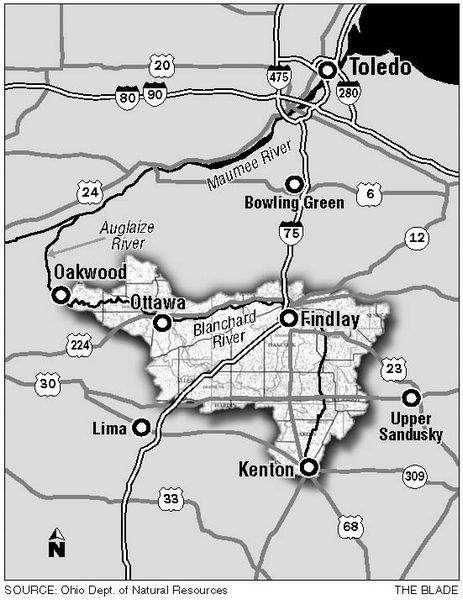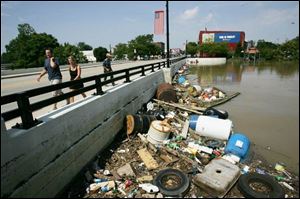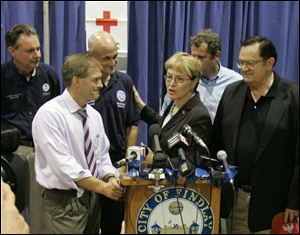
City of Findlay aiming for long-term fixes
8/26/2007
Findlay Mayor Tony Iriti wants Congress to authorize the U.S. Army Corps of Engineers to study and implement long-term solutions for flooding issues along the 95-mile Blanchard River. Severe flooding occurred in much of the Blanchard River Watershed area this last week.
FINDLAY If it took a devastating flood to get the federal government s attention, Findlay Mayor Tony Iriti figures that may just be the silver lining of last week s catastrophe.
The mayor is hoping the national spotlight beamed on his saturated city this last week will boost his bid to convince Congress to authorize the U.S. Army Corps of Engineers to begin the lengthy and expensive process that would lead to a flood-control plan for the Blanchard River.
When you have the secretary of Homeland Security, the national director of [the Federal Emergency Management Agency], [U.S. Sen.] Sherrod Brown, and all of the big folks coming to town because of this catastrophic situation, then maybe that is what it takes, Mr. Iriti said. Maybe that s what will make people start to understand that in order to effect a long-term solution, they have to help us. We can t do this alone and without having a comprehensive plan to make it happen.
Following a series of smaller floods in December and January, the mayor went to Washington in March to try to convince legislators to authorize the Corps of Engineers to proceed with a feasibility study of the Blanchard River the first step in an estimated six-year process.
Nothing happened.
On Friday, Mr. Iriti said he planned to return to Washington as early as this week to renew his plea.

Findlay residents stroll across the Main Street bridge as debris from the recent Blanchard River flooding begins to accumulate along the river s shore.
If I can t convince federal legislators to authorize the Army Corps, every funding cycle we go through adds another year to the end of this thing, the mayor said. That s my frustration, is trying to get people to take notice.
That may be less of a problem now.
After heavy rains Monday and Tuesday sent the Blanchard 7.5 feet above flood stage and displaced hundreds of Findlay residents, people began to take notice.
U.S. Rep. Marcy Kaptur (D., Toledo) was among the legislators who visited Findlay to pledge their support. At a news conference with Gov. Ted Strickland and Homeland Security Director Michael Chertoff, Miss Kaptur pointed out the Corps absence and accused the agency of dragging its feet about addressing flooding along the Blanchard and the entire western Lake Erie basin.
The Blanchard River has been swelling for a long time, and what happens is that when it overflows, in certain situations it flows into the Maumee River and it helps flood Toledo, Miss Kaptur said. And we have to handle this on a watershed basis with reservoirs, dry dams, with better planting in the countryside to condense the water.
This is a real wake-up call for everyone in the western basin to get it back together and to better manage this precious, fresh-water access.

Findlay Mayor Tony Iriti wants Congress to authorize the U.S. Army Corps of Engineers to study and implement long-term solutions for flooding issues along the 95-mile Blanchard River. Severe flooding occurred in much of the Blanchard River Watershed area this last week.
Bruce Sanders, spokesman for the Corps Buffalo district, said the Corps has been in discussions with Findlay officials for months, but last week s flood moved the Blanchard River higher on its priority list.
At this very moment we are discussing in the Buffalo district, under our [Continuing Authorities Program], seeing if we can transfer money from projects that are not as high priority to projects that are high priority, for example, Findlay, Mr. Sanders said Friday afternoon. We are looking at trying to move funds that will allow us to move forward on Findlay.
The Continuing Authorities Program provides funding for small but immediate projects, he said, and does not require congressional authorization. Mr. Sanders said the Corps may be able to reallocate enough CAP dollars to help pay for an initial feasibility study on the Blanchard.
Mr. Sanders said the flooding solutions could include structural fixes, such as levies and dams, as well as nonstructural solutions, such as managing development.
The city has been working on the problem in the meantime.
This summer, Findlay spent $700,000 to lower the Liberty Street dam from eight feet to four feet and remove obstructions from the river in an effort to allow the water to move more freely.

R. David Paulison, left, federal FEMA administrator, Michael Chertoff, U.S. Homeland Security secretary, U.S. Rep. Marcy Kaptur, Ohio Sen. Sherrod Brown, and U.S. Rep. Paul Gillmor discuss the flooding at a news conference.
Last month, City Council agreed to spend $192,000 to install and maintain a flood warning system for the river, with the U.S. Geological Survey picking up about half of the system s $266,000 cost.
Those gauges have not yet been installed but should give residents earlier notice of when and where the river will flood.
H. Richard Rowe, Findlay at-large councilman, said the city has been doing what it can but has struggled to get the attention of the Corps of Engineers, which controls what is done to the river.
It s not a lack of ability. It s a lack of money and a lack of getting the attention of other agencies that really have the final say, Mr. Rowe said. The city legally cannot touch the river without FEMA and the Army Corps of Engineers giving the OK, and in some cases, they have to do the work.
Mr. Rowe said he supports the idea of partnering with Hardin and Putnam counties to build a 1,000-acre lake at the Hancock-Hardin county border that could act as a massive retention pond and at least slow down the river s flow after a heavy rainfall. He knows any solution will be expensive.
How high do people want their taxes to go up to pay for this? Mr. Rowe asked. There s always a tradeoff.
The city had the opportunity to implement a $12 million flood-control plan in 1962 that would have involved building flood walls similar to what Tiffin and Fremont have.
The Army Corps of Engineers would have paid about $9 million of the tab, with the balance coming primarily from assessments on property owners.
City Council at the time declined.
There is an element in Hancock County that believes there should never be a dime spent, Mr. Rowe said.
Robert McCall, watershed agent for the Ohio State University Extension Service s west district, said the three-year-old Blanchard River Watershed Council has been putting together a strategic plan that includes diverse ideas for restoring or increasing the watershed s water-holding capacity. Not all of them are expensive.
Options range from restoring wetlands to building detention ponds, implementing farming methods that minimize runoff, and encouraging urban solutions such as rain gardens where rainwater is captured so that it can be used later for other purposes.
When you put all these things together, it can help, Mr. McCall said, adding, And it s a lot less costly than digging a ditch from here to Lake Erie.
Whatever Findlay decides to do to address flood control, those plans will not be overseen by Mayor Iriti, who was defeated in the Republican primary in May by newcomer Peter Sehnert.
Mr. Sehnert, who is a retired Findlay police officer, and his Democratic challenger, Thomas Knopf, an insurance coordinator for a Bowling Green-based mental health agency, both said flood control will be a priority for their administration, although neither has a specific plan for addressing it.
I m sure there are engineers and people who work with that all the time and know a lot more than I ll ever know about the river, Mr. Sehnert said, adding that he supports the current administration s efforts.
Mr. Knopf said he too wants to see the city continue down the course it s following toward flood control.
I give credit to Mayor Iriti for getting the ball rolling and starting the process that needed to be done, he said.
Mr. Iriti said even though he will only be mayor for four more months, he s forging ahead.
It s kind of ironic because the four flooding events that occurred last year probably had a little to do with the fact that I m leaving office, Mr. Iriti said, noting that some city residents believed officials weren t doing enough to prevent flooding.
But I m committed now, as I was then, that I will do everything that is reasonable and necessary to get Congress to get this long-term process started, and future mayors and future councils can make it all happen, he said.
Blade staff writer Joe Vardon contributed to this report.
Contact Jennifer Feehan at:jfeehan@theblade.comor 419-353-5972.